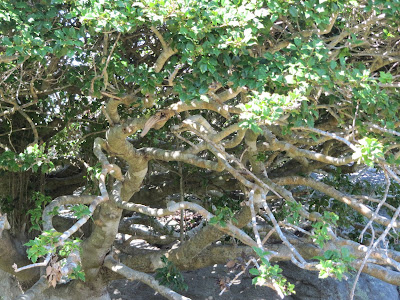 |
| Naushon Tree by Brad Gibson |
aparigraha sthairye janma kathanta sambodhah
When one is steadfast in non-possessiveness or non-grasping with the senses there arises knowledge of the why and wherefore of past and future lives. —trans. by Swami Jnaneshvara
Aparigraha comes from the word parigraha, which means reaching out for something and claiming it for oneself; the "a" prefix' before parigraha turns it into an antonym. Thus, aparigraha is the concept of non-possessiveness or non-hoarding. Aparigraha means to limit possessions to what is necessary or important and taking what is truly necessary and no more. Nina briefly touched on this topic in one of her earlier postings (see Yama Drama).
Our senses are like portals or gateways into our body, mind and consciousness. We are what we eat, smell, see, hear and touch. Through our senses, we absorb the world around us. If we take in harmonious impressions, we will in turn be healthier. If we absorb disharmonious impressions through our senses, we are inviting with it all kinds of body-mind problems. Through these five senses we get attracted to material possessions and surround ourselves with them. Hoarding is the accumulation of things that may have little or no value. So great is the need to accumulate these things that they then becomes difficult to part with it. Hoarders accumulate and store old newspapers, food cartons, cans, mail, notes, clothes, garbage and other debris. Hoarding begins slowly and builds over time. Hoarders will not give up their possessions as they develop an emotional attachment to their belongings and have a distorted view about the importance/lack of importance of material possessions. People who develop a habit of hoarding identify their possessions as a part of their identities. Losing or disposing of a possession may produce extreme anxiety or a sense of loss and grief. Researchers believe that individuals who are experiencing emotional upheavals in their lives when faced with aging and the possibility of outliving their resources may begin to collect and save as these material possessions provides them a sense of security—sort of a comfort zone.
But hoarding is not just about accumulating material possessions. It is also about hoarding/holding thoughts and emotions that affect our normal mindset and thinking process. Hoarding, be it mental or physical, is associated with an inability to process information and make decisions when confronted with a large amount of information, attention and focus deficits and a failure of categorization. We tend to fill our minds with fear, worry, anxiety, grief, anger, rage, jealousy, and judgments, among others, and we do not let go of these emotions. Over time, these emotions—whether it be bitterness, fear, emotional damage, rejection or abandonment—build up. If you hoard/accumulate unexpressed or suppressed emotions and if they are not getting released, they keep building up in your body. Ultimately these pent-up emotions can trigger mental and/or physical pathological conditions. Thus, hoarding emotions can be devastating to both mind and body.
What is the easiest and effective way to ward off emotional hoarding? A simple method is meditation (dhyana), the cheapest and simplest recourse to a healthy body and mind (see Balancing Your Emotions with Your Breath). While meditation may not cure a person from the act of hoarding, the person having a meditation practice will react to life’s turbulence differently. This reaction and suitable action measures comes from a true awareness; awareness to the emotional turbulence arising from within that has remedial effects. As explained in an earlier post (see Never Go to Bed Angry), the individual will not only have the capacity to transcend the physical and emotional upheaval but will also not evoke the same physical and emotional reactions that are commonly seen in a person who does not meditate.
Just as you take a car for a regular tune up, you also need to detoxify and tune up our body and mind on a periodical basis. Disposing of any unwanted material possessions and detoxifying our mind-riddled emotions on a regular basis is a panacea for healthy aging and living. If you can do it for your car, you might as well think about doing the same for your mind and body.
No comments:
Post a Comment